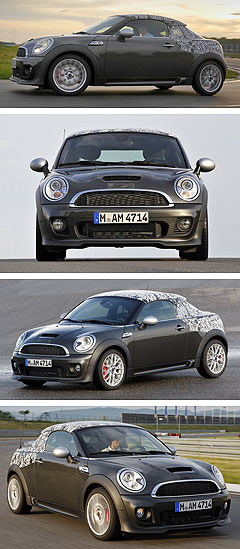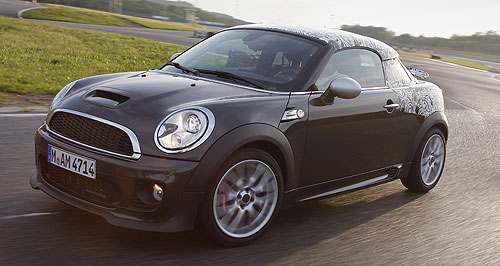Future models - Mini - CoupeFull details: Mini Coupe confirmed for OzFlown the coupe: The fast-back, two-seater Mini Cooper Coupe - seen here in semi-disguise - has been confirmed for Australian sale. Complete engine line-up revealed for new Mini Coupe before its late-2011 release7 Jun 2011 BMW has announced full details of the Mini Coupe well before it makes its world debut in final production form with a full complement of top-shelf turbo petrol and diesel engines at the Frankfurt motor in September. The fast-backed two-seater, semi-disguised images of which were also revealed in Europe yesterday, has now been confirmed for release Down Under, but BMW Australia says details of its local launch - including timing, pricing and specifications - will be “confirmed at a later date”. Although spy-proof adhesive graphics cover its roof and rear-end, the fifth member of Mini’s expanding model family - which along with the new Mini Roadster was announced for production ahead of the global premieres of both models at the 2009 Frankfurt show – appears to be faithful to the show car that appeared in Germany 20 months ago. However, in addition to a sleek roof spoiler, the two-door’s rear tailgate – which hinges from the roof and includes the rear window, thereby technically making it a hatchback and not a coupe – also comprises a pop-up rear wing that is housed within the rear decklid. While the active rear spoiler deploys automatically at 80km/h and is said to optimise airflow at high speeds, BMW says an abundance of storage space, an “extremely high-opening” tailgate and through-load facility also make the Mini Coupe a highly versatile daily driver. No cargo capacities have been revealed, but the Mini Coupe concept’s luggage space was claimed to be 250 litres – up from the standard hatch’s 160 litres.  Apart from its ‘faster’ front and rear windows, booted rear-end and chopped “helmet” roof design – which was allegedly inspired by a backwards baseball cap - Mini’s first modern two-seater appears identical to the three-door four-seater hatch upon which it is based. Apart from its ‘faster’ front and rear windows, booted rear-end and chopped “helmet” roof design – which was allegedly inspired by a backwards baseball cap - Mini’s first modern two-seater appears identical to the three-door four-seater hatch upon which it is based.No interior images of Mini’s direct response to the Peugeot RCZ and Audi TT have been released, but the Mini Coupe cabin – as previewed by the concept - is expected to be as unique as its three-box exterior. Like other Minis, the coupe concept’s two-tone brown leather-clad interior featured a massive speedo mounted centrally on the dashboard, with a large tacho mounted behind the steering wheel, flanked by a pair of Chronoswiss clocks - one to tell the time, the other for lap timing. Of course, BMW says all elements of the racy new two-seater have been engineered for “optimum performance”, including a specific chassis tune that rides 29mm lower than the standard Mini (not 59mm like the concept), plus improved weight distribution, aerodynamics and the most powerful versions of BMW’s latest turbocharged four-cylinder petrol and diesel engines. “As a result, the new car radiates the brand’s hallmark go-kart feeling with a whole new depth of intensity and achieves the best performance statistics ever recorded by a volume-produced Mini,” says BMW. The Munich maker says its new super-compact sportscar will deliver “unrivalled handling agility and the best performance figures of any model in the Mini line-up” and “a level of chassis quality unmatched in the small car segment”. Accompanying “measures designed specifically to optimise torsional rigidity” are familiar Mini technologies like electric power steering, electronic stability control and dynamic traction control systems, plus a standard six-speed manual transmission. A six-speed automatic will be optional for all models except the JCW flagship, which will be the only version to come standard with Electronic Differential Lock Control (EDLC), although the weight balance of all models has been shifted slightly further forward to increase front-wheel drive traction. Official dimensions reveal the Mini Coupe to be up to 35mm longer overall than the Cooper hatch at 3728mm (3734mm for the Cooper S and JCW), but almost 30mm lower at 1378mm high (1384mm for the Cooper S and JCW). As with the Cooper hatch, however, the coupe measures 1683mm wide and rides on a 2467mm wheelbase. Also like the hard-top hatch, soft-top Cabrio and long-wheelbase Clubman wagon it will be built alongside in Oxford later this year (the Countryman SUV is built in Austria), the coupe will also wear Mini’s beloved Cooper model nameplate. As such, the range-topping Mini John Cooper Works Coupe will feature the most powerful version of the new 1.6-litre twin-scroll turbocharged direct-injection petrol engine revealed by BMW earlier this year. The Mini JSW Coupe delivers 155kW at 6000rpm and 260Nm of torque between 1850 and 5600rpm (280Nm between 1700 and 4500rpm during overboost), which Mini claims is enough to propel it to 100km/h in just 6.4 seconds – one-tenth quicker than the most rapid JCW hatch. The newest JCW’s top speed is listed at some 240km/h, yet fuel consumption remains relatively frugal at 7.1L/100km and CO2 emissions are 165g/km. The nest most potent model is the Mini Cooper S Coupe, which once again delivers the same outputs as the regular Mini Cooper S - 135kW at 5500rpm and 240Nm at 1600-5000rpm (overboost: 260Nm at 1700-4500rpm). In the case of the coupe – for which no kerb weights have been supplied, although the concept was said to be 100kg lighter than the hatch – that is enough to again lower 0-100km/h acceleration by a tenth to 6.9 seconds, and to offer a 230km/h top speed. Fuel consumption and CO2 emissions for the Cooper S Coupe are listed at a respective 5.8L/100km and 136g/km. The most basic Cooper Coupe offers 90kW at 6000rpm and 160Nm at 4250 from the same 1.6-litre turbo-petrol four, increasing the 0-100km/h acceleration time to nine seconds and reducing top speed to 204km/h, while reducing fuel consumption and emissions to 5.4L/100km and 127g/km. Rounding out the newest Mini model line is the Cooper SD Coupe, powered by BMW’s familiar 2.0-litre all-alloy common-rail turbo-diesel with variable turbo technology. Developing 105kW at 4000rpm and 305Nm at 1750-2700rpm, it sprints to 100km/h in a claimed 7.9 seconds and a 216km/h top speed, while being able to return just 4.3L/100km and 114g/km. Expect BMW to release details of the new Mini Roadster ahead of its release in 2012 – the same year Mini’s MkIII hatch is due to appear. Apart from donating its new front-drive platform for an all-new ‘0 Series’ model to be positioned between BMW’s 2013 i3 city-EV and the upcoming second-generation 1 Series range by 2014, the new hatch could also spawn production versions of a host of recent Mini concepts. They include the Paceman from the 2011 Detroit show and the Moke-inspired Beachcomber from the 2010 Detroit show, while the carbon-fibre space-framed Rocketman from this year’s Geneva show could preview the general styling direction of all future Minis.  Read more8th of March 2011  Geneva show: Fiat’s 500 branches out500-based Zagato Coupe could be Fiat’s answer to the Mini Coupe24th of February 2011  Geneva show: Rocketman hints at Mini directionHigh-tech take on classic Mini values for ‘Rocketman’ Geneva concept20th of December 2010  Detroit show: Mini makes the PacemanStretched three-door Mini Paceman Concept gets the streamlined coupe treatment16th of December 2009  First look: Mini does a MokeBeachcomber concept reprises Moke as Mini gets set to launch baby SUV in 20107th of September 2009  Mini confirms coupe production at Oxford plantBMW green-lights Mini coupe concept and sister model for production at British plant |
Click to shareMini modelsResearch Mini Motor industry news |















Facebook Twitter Instagram